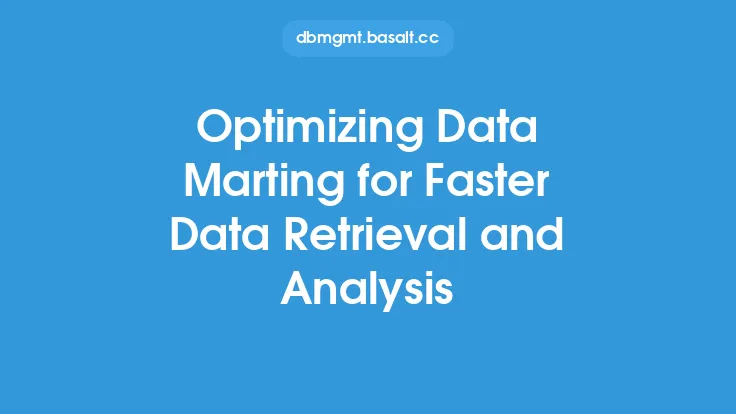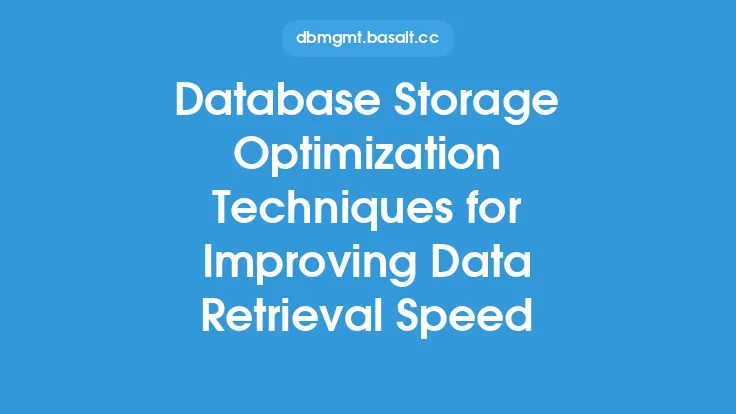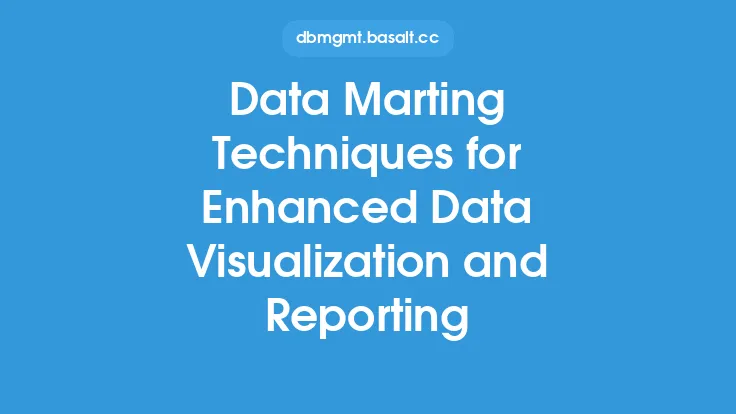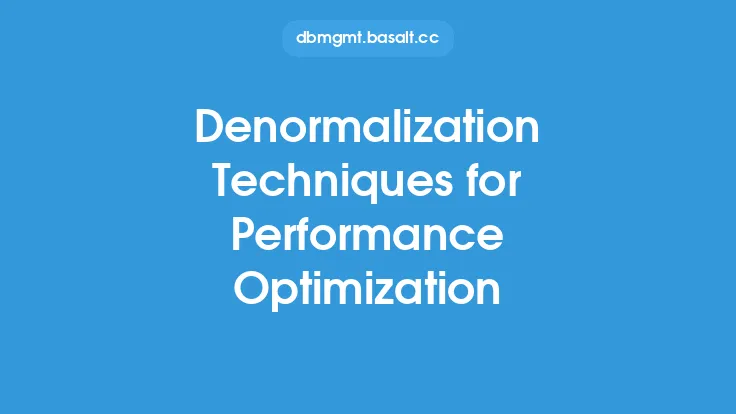Denormalization is a database optimization technique that involves intentionally deviating from the principles of normalization to improve data access and retrieval speeds. Normalization is the process of organizing data in a database to minimize data redundancy and dependency, which can lead to data inconsistencies and anomalies. However, in some cases, normalization can result in slower query performance due to the need for joins and other complex operations. Denormalization techniques aim to address this issue by allowing some degree of data redundancy and dependency in order to improve data access and retrieval speeds.
Introduction to Denormalization Techniques
Denormalization techniques involve modifying the database schema to store data in a way that is optimized for query performance. This can involve duplicating data, storing aggregated values, or using other techniques to reduce the number of joins and other complex operations required to retrieve data. Denormalization techniques can be applied to various types of databases, including relational databases, NoSQL databases, and data warehouses. The goal of denormalization is to improve data access and retrieval speeds, which can be critical in applications where fast data retrieval is essential, such as in real-time analytics, gaming, and other high-performance applications.
Types of Denormalization Techniques
There are several types of denormalization techniques, each with its own strengths and weaknesses. Some common denormalization techniques include:
- Data duplication: This involves duplicating data in multiple tables to reduce the need for joins and other complex operations.
- Data aggregation: This involves storing aggregated values, such as sums or averages, to reduce the need for complex calculations.
- Data caching: This involves storing frequently accessed data in a cache to reduce the need for database queries.
- Materialized views: This involves storing the results of complex queries in a materialized view to reduce the need for repeated calculations.
- Pre-computation: This involves pre-computing complex calculations and storing the results in a table to reduce the need for repeated calculations.
Benefits of Denormalization Techniques
Denormalization techniques can offer several benefits, including:
- Improved data access and retrieval speeds: Denormalization techniques can reduce the need for complex operations, such as joins and aggregations, which can improve data access and retrieval speeds.
- Reduced query complexity: Denormalization techniques can simplify complex queries by reducing the need for joins and other complex operations.
- Improved data readability: Denormalization techniques can make data more readable by storing data in a way that is optimized for human consumption.
- Improved data scalability: Denormalization techniques can improve data scalability by reducing the need for complex operations, which can become bottlenecks as data volumes increase.
Challenges and Limitations of Denormalization Techniques
While denormalization techniques can offer several benefits, they also present several challenges and limitations. Some of the challenges and limitations of denormalization techniques include:
- Data consistency: Denormalization techniques can lead to data inconsistencies and anomalies, which can be difficult to manage and maintain.
- Data redundancy: Denormalization techniques can lead to data redundancy, which can result in wasted storage space and increased maintenance costs.
- Data complexity: Denormalization techniques can add complexity to the database schema, which can make it more difficult to manage and maintain.
- Query optimization: Denormalization techniques can make it more difficult to optimize queries, which can result in slower query performance.
Best Practices for Implementing Denormalization Techniques
To get the most out of denormalization techniques, it is essential to follow best practices for implementing them. Some best practices for implementing denormalization techniques include:
- Carefully evaluate the trade-offs: Denormalization techniques can offer several benefits, but they also present several challenges and limitations. It is essential to carefully evaluate the trade-offs before implementing denormalization techniques.
- Start with a normalized database: It is essential to start with a normalized database and then apply denormalization techniques as needed.
- Use denormalization techniques judiciously: Denormalization techniques should be used judiciously and only when necessary. Over-denormalization can lead to data inconsistencies and anomalies.
- Monitor and maintain the database: It is essential to monitor and maintain the database regularly to ensure that denormalization techniques are not leading to data inconsistencies and anomalies.
Common Use Cases for Denormalization Techniques
Denormalization techniques are commonly used in various applications, including:
- Real-time analytics: Denormalization techniques are commonly used in real-time analytics to improve data access and retrieval speeds.
- Gaming: Denormalization techniques are commonly used in gaming to improve data access and retrieval speeds and to reduce latency.
- E-commerce: Denormalization techniques are commonly used in e-commerce to improve data access and retrieval speeds and to reduce latency.
- Social media: Denormalization techniques are commonly used in social media to improve data access and retrieval speeds and to reduce latency.
Conclusion
Denormalization techniques are a powerful tool for improving data access and retrieval speeds. By intentionally deviating from the principles of normalization, denormalization techniques can reduce the need for complex operations, such as joins and aggregations, and improve data scalability. However, denormalization techniques also present several challenges and limitations, including data consistency, data redundancy, and data complexity. To get the most out of denormalization techniques, it is essential to follow best practices for implementing them and to carefully evaluate the trade-offs. By using denormalization techniques judiciously and monitoring and maintaining the database regularly, organizations can improve data access and retrieval speeds and reduce latency, which can be critical in applications where fast data retrieval is essential.





